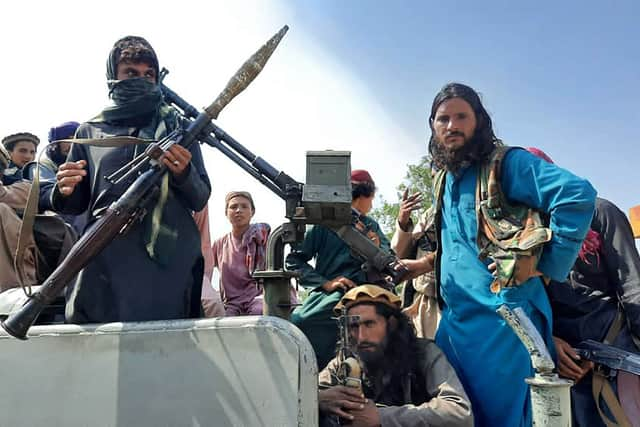Who is the leader of the Taliban? Is Hibatullah Akhundzada still alive - and head of the group in Afghanistan
This article contains affiliate links. We may earn a small commission on items purchased through this article, but that does not affect our editorial judgement.
and live on Freeview channel 276
The interim government formed in Afghanistan is not the “diverse group of leadership” that can address equality pledges made by the Taliban, Downing Street has suggested.
The Taliban announced an interim cabinet of hardliners on Tuesday (7 September), composed completely of men and including a number of figures connected to attacks on US forces.
Advertisement
Hide AdAdvertisement
Hide AdThe US State Department said it was “concerned by the affiliations and track records” of some of the senior leaders, and in a statement said: “We will judge the Taliban by its actions, not words. We have made clear our expectation that the Afghan people deserve an inclusive government.”
On Wednesday, Downing Street said it shared those concerns.
Here is everything you need to know about it.
Who is in the new Taliban government?
Many of the top posts have been handed to those who dominated the 20-year conflict with the West.
Sirajuddin Haqqani, the country’s new interior minister, appears on the FBI’s most-wanted list with a reward of $10 million (£7.26 million) for his capture.
The FBI said he is believed to have coordinated and participated in cross-border attacks against United States and coalition forces in Afghanistan and described him as a “specially designated global terrorist” with close links to al-Qaeda.
Advertisement
Hide AdAdvertisement
Hide AdOther members are reported to have been previously held at Guantanamo Bay for terror offences.
It comes after the group attempted to present its takeover in Afghanistan as a marked departure from their past rule.
Who is the leader of the Taliban government?
The interim prime minister of Afghanistan - though the government remains unrecognised internationally - is Mullah Hasan Akhund.
According to UN Security Council data, Hassan Akhund was born in Pashmul in Kandahar Province, which is widely considered the spiritual home of the Taliban.
Advertisement
Hide AdAdvertisement
Hide AdThe UN has two estimates for his year of birth, being approximately 1945 - 1950, and approximately 1955 - 1958.
Akhund is one of the oldest members of the Taliban, and was a close associate of Mohammed Omar, the first leader of the movement.


He served as the deputy foreign minister of Afghanistan during the Taliban’s rule between 1996 and 2001, and was also the deputy prime minister during that period.
Akhund’s appointment as interim Prime Minister is seen by many as a compromise between Taliban's moderate and hardline figures, and it is thought he is more influential on the religious side of the Taliban, as opposed to the military side.
Advertisement
Hide AdAdvertisement
Hide AdAkhund is on a UN blacklist, and is subject to sanctions related to the sheltering of terrorist groups.
Who is the leader of the Taliban?
Though Akhund has been instated as the leader of the Taliban’s political movements in Afghanistan, he is not the true leader of the group.
That role is instead fulfilled by Hibatullah Akhundzada, the Third Supreme Leader of the Taliban, and the group’s “Amir al-Mu'minin” (Commander of the Faithful).
Akhundzada was born in 1961 in the Panjwai district of Kandahar Province, before his family migrated to the Balochistan province of Pakistan after the Soviet invasion of Afghanistan.
Advertisement
Hide AdAdvertisement
Hide AdIn the 1980s he was "involved in the Islamist resistance" to the Soviet military campaign, and Akhundzada joined the Taliban in 1994 after the Soviet Union left Afghanistan.
He quickly became the head of the Taliban's military court, and then the deputy head of the Supreme Court.
After the Taliban government fell to the US-led invasion in 2001, Akhundzada became the head of the group's council of religious scholars.
Rather than a military commander, he has a reputation as a religious leader who was responsible for settling religious issues among members of the Taliban.
Advertisement
Hide AdAdvertisement
Hide AdHe was appointed as one of two deputy leaders of the Taliban under previous leader Akhtar Mansour in 2015, and became the most visible face of the Taliban's top leadership
Akhundzada was elected as the leader of the Taliban in May 2016, following the death of Mansour in a drone strike.
With little known about Akhundzada and a lack of photographs in the aftermath of the fall of Kabul, questions have been raised about whether he is alive.
Rumours in February 2021 suggested he was killed in an explosion in Pakistan, but this was dismissed by the Taliban.
A message from the editor:
Advertisement
Hide AdAdvertisement
Hide AdThank you for reading. NationalWorld is a new national news brand, produced by a team of journalists, editors, video producers and designers who live and work across the UK. Find out more about who’s who in the team, and our editorial values. We want to start a community among our readers, so please follow us on Facebook, Twitter and Instagram, and keep the conversation going. You can also sign up to our newsletters and get a curated selection of our best reads to your inbox every day.
Comment Guidelines
National World encourages reader discussion on our stories. User feedback, insights and back-and-forth exchanges add a rich layer of context to reporting. Please review our Community Guidelines before commenting.
